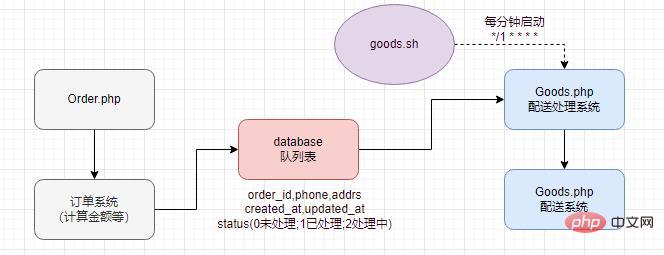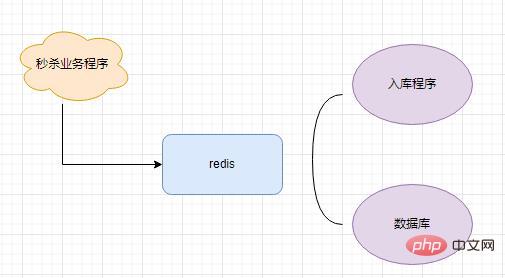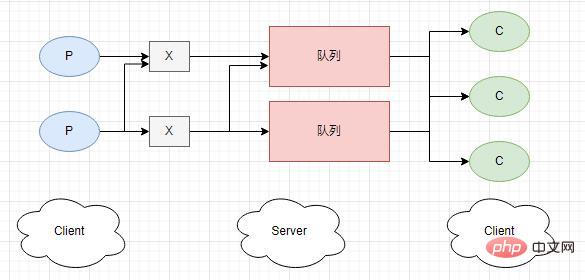

Architecture design 1 using scheduled tasks
When using the distribution processing system for processing, update the status of the order to be processed in the current database to 2, and set the status to 1 after the processing is completed
You can specify how many pieces of data to update each time
Use queue data Structure
are illustrated as follows
// Spike.php 秒杀程序if(Redis::llen('lottery') // Warehousing.php 入库程序while(true){ $user = Redis::rpop('lottery'); if (!$user || $user == 'nil') { sleep(2); continue; } $user_arr = explode($user, '%'); $insert_user = [ 'uid' => $user_arr[0], 'time' => $user_arr[1] ]; $res = DB::table('lottery_queue')->insert($insert_user); if (!$res) { Redis::lpush('lottery', $user); }}
Copy after login
// 先将商品放入redis中 $goods_id = 2; $sql = select id,num from goods where id = $goods_id; $res = DB::select($sql); if (!empty($res)) { // 也可以指定多少件 Redis::del('lottery_goods' . $goods_id); for($i=0;$i // 开始秒杀 $count = Redis::rpop('lottery_goods' . $goods_id); if (!$count) { // 商品已抢完 ... } // 用户抢购队列 $user_list = 'user_goods_id_' . $goods_id; $user_status = Redis::sismember($user_list, $user_id); if ($user_status) { // 已抢过 ... } // 将抢到的放到列表中 Redis::sadd($user_list, $uid); $msg = '用户:' . $uid . '顺序' . $count; Log::info($msg); // 生成订单等 ... // 减库存 $sql = update goods set num = num -1 where id = $goods_id and num > 0; // 防止超卖 DB::update($sql) // 抢购成功
Copy after login
where P represents production Or, X is the switch (channel), C represents the consumer
// Send.php require_once __DIR__.'/vendor/autoload.php'; use PhpAmqpLib\Connection\AMQPStreamConnection; use PhpAmqpLib\Message\AMQPMessage; $connection = new AMQPStreamConnection('localhost', 5672, 'guest', 'guest'); // 创建通道 $channel = $connection->channel(); // 声明一个队列 $channel->queue_declare('user_email', false, false, false, false); // 制作消息 $msg = new AMQPMessage('send email'); // 将消息推送到队列 $channel->basic_publish($msg, '', 'user_email'); echo '[x] send email'; $channel->close(); $connection->close();
// Receive.php require_once __DIR__.'/vendor/autoload.php'; use PhpAmqpLib\Connection\AMQPStreamConnection; use PhpAmqpLib\Message\AMQPMessage; $connection = new AMQPStreamConnection('localhost', 5672, 'guest', 'guest'); //创建通道 $channel = $connection->channel(); $channel->queue_declare('user_email', false, false, false, false); // 当收到消息时的回调函数 $callback = function($msg){ //发送邮件 echo 'Received '.$msg->body.'\n'; }; $channel->basic_consume('user_email', '', false, true, false, false, $callback); // 保持监听状态 while($channel->is_open()){ $channel->wait(); }
The above is the detailed content of Detailed explanation of the implementation and application of PHP message queue (with flow chart). For more information, please follow other related articles on the PHP Chinese website!